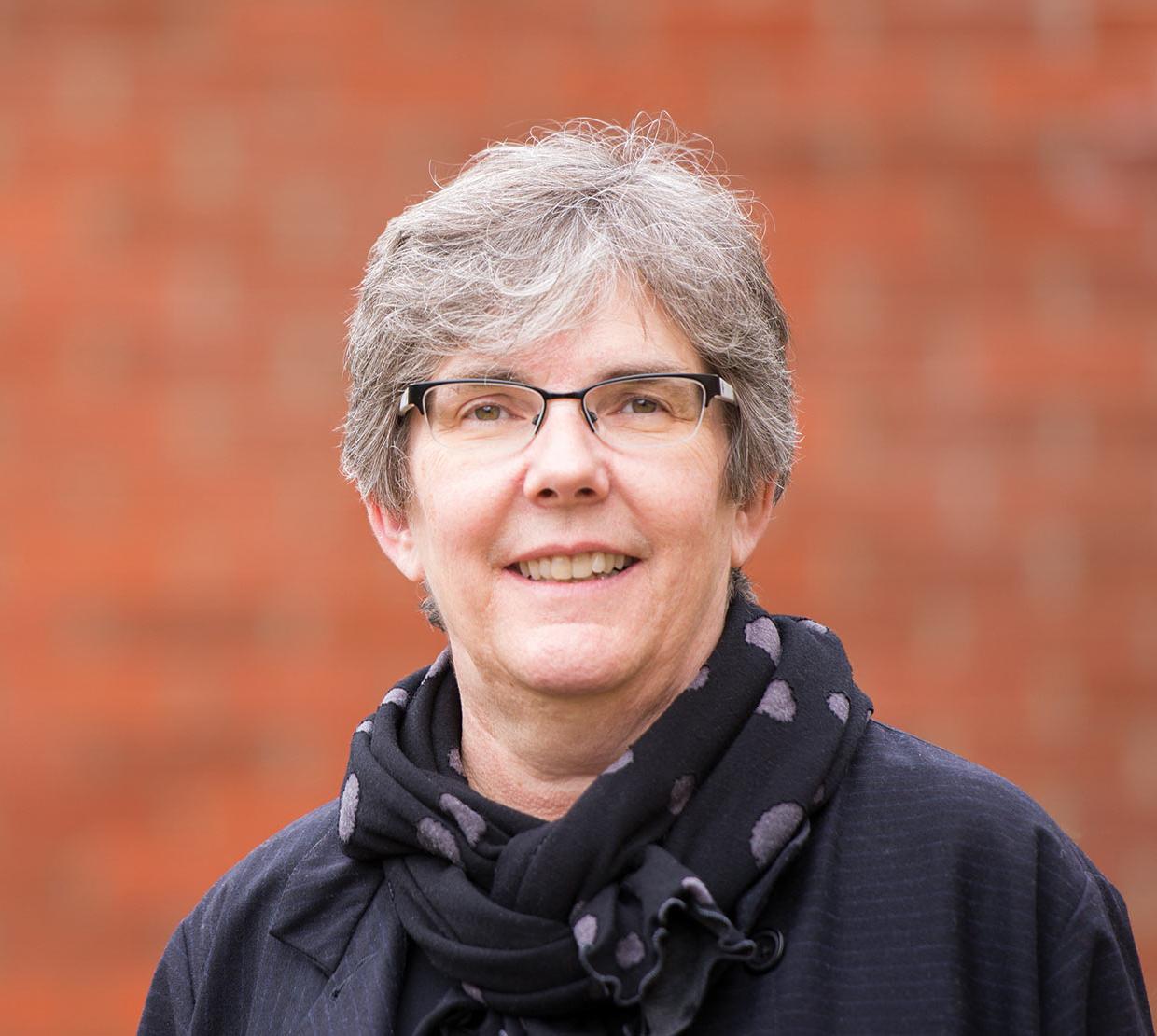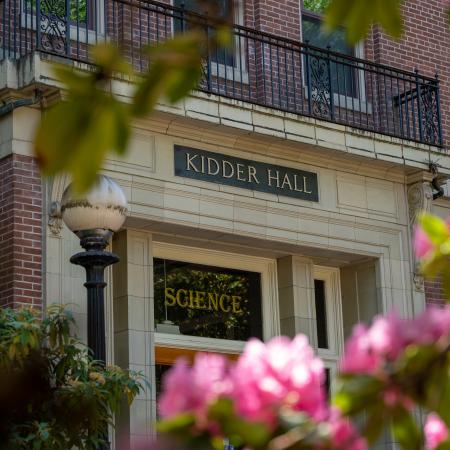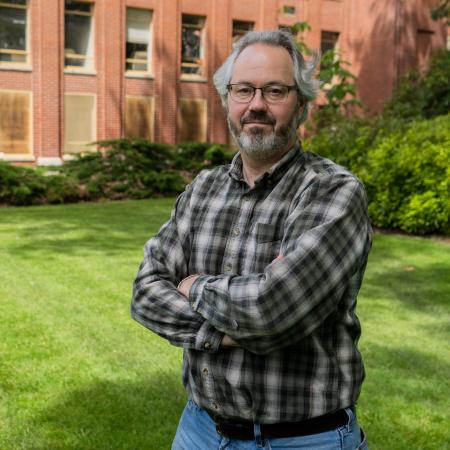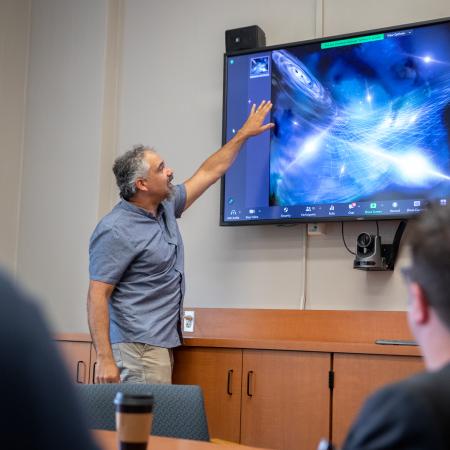Heidi Schellman arrived at Oregon State in 2015 to chair the physics department, drawn to its world-class research, innovative teaching, and mission as part of a public land-grant university to open the doors of higher education to all. Recently tapped to lead a commission of the International Union for Pure and Applied Physics (IUPAP), Schellman is a leader on campus as well as on an international stage. She is one of those rare academics who has remained engaged and successful in three distinct areas — research, teaching and administration — over a lifetime.
A warm, approachable presence in Weniger Hall who is as likely to show you pictures of her cat on her phone as to discuss the relationship between electroweak parameters and proton structure, Schellman is fully dedicated to students and the exciting future of OSU physics, despite ongoing challenges. Recently she made time in her busy schedule to sit down for a chat.
What was the transition like to Oregon State from Northwestern University?
First of all, I felt like I was coming home. I grew up in Eugene but then moved away for almost 40 years for college (Stanford University), graduate school (University of California, Berkeley) and then a faculty position at Northwestern. As Chair of Physics and Astronomy at Northwestern for four years, I got to meet department chairs from the large land-grant universities. The invitation to come to Oregon State was a dream come true – I wanted to work at a place that shared my goals for education and valued teaching as well as research.
Along those lines, when I first got here I prepared for teaching my first Modern Physics class by observing award-winning instructor K.C. Walsh and stealing as many of his methods as possible. At Northwestern, I had mainly lectured the old-fashioned way to a room of bored-looking students who took notes. At OSU, I use far more hands-on activities in the classroom that make it easy for students to engage and to learn. It’s a much more effective and satisfying teaching style. I’m happy to say that, after a year or so on the job, I’ve made considerable progress towards OSU physics’ extremely high standards of teaching.
As head of the Department of Physics, what most excites you about its future? What concerns you?
We have a great group of young faculty and a growing group of majors. Our faculty and students take physics education very seriously and are national leaders in curricular reform. Students everywhere find physics difficult, but our faculty work very hard to make it fun to learn. All of our majors do original research and write a senior thesis, both of which are very rare and highly valued both by employers and graduate schools.
On the concern side, our physical facilities in Weniger Hall are in dire need of an upgrade. The building is a time capsule of 1960s scientific infrastructure. Many of the classrooms were planned for two-thirds of their current occupancy. We could definitely use some capital improvements. I have a long wish-list for anyone who would like to listen...
What are you working on now in your own research, and what are you most proud of in terms of past research?
This is where it gets complicated. I work in high-energy physics, which involves building huge scientific apparatus and then running it for years to get data. My specialty is studying the weak interactions, which are responsible for radioactive decay — and the sun shining — but aren't often encountered in everyday life. Right now, I’m studying the interactions of neutrinos, very light elementary particles that interact very rarely. My former student Cheryl Patrick, postdoc Laura Fields and I just submitted a 47-page paper on anti-neutrino scattering. That work was the result of around three years of construction, two years of 24/7 data tracking and three years of statistical analysis.
As you can see, the logistics in physics research are challenging, requiring collaboration, funding and a long timeline. To appreciate that even more, consider that the apparatus for our neutrino-scattering experiment lies 300 feet underground in Illinois and was built and run by around 70 physicists from all over the world. And that’s a small experiment! My previous research involved 500 collaborators and my next project, the DUNE neutrino oscillation experiment, already has 1,000 signed up.
As for what I’m most proud of in my research, it would be the young scientists I’ve mentored over the years. All of my best papers have been written with excellent students and postdocs and many of them are still around, often now giving me orders as they run the large projects I work on!
What is most misunderstood about physics?
That it’s a bunch of formulas to memorize. We do use mathematical formulas to express ideas, but it’s the concepts that count, not the formulas we use to communicate. For example, E = mc2 is a very famous formula, but as a concept it has broad implications – including our ability to use high energy particle beams to create new particles.
What is most misunderstood about research in physics, if such a thing can be generalized about at all?
I think the main thing people don’t realize is that a very large fraction of our research equipment is built for that specific experiment by hand, often by students. When you’re doing something completely new, you can’t go out and buy these things off the shelf. This novel experiment-driven apparatus sometimes leads to inventions and technologies that can end up being a commercial success. As a summer intern before graduate school, for example, I helped calibrate magnets for the Stanford Synchrotron Radiation Lightsource. That technology is now a billion-dollar industry but back then each magnet was a one-off and very idiosyncratic. Later I helped build a software system that allowed us to store and catalog petabytes of data across facilities world-wide. Nowadays people can buy such a service commercially with their credit card but 20 years ago, we had to build our own.
Since physics research involves such a huge investment, it often requires global stakeholders and collaborators. In your research and as Chair of Commission 11 of the IUPAP, give us a sense of what international collaboration is really like?
It means trying to learn about different cultures and trying very hard to be polite, which is not something Americans are always good at. One very nice thing is that national conflicts are studiously avoided. For example, the Czech and Slovak students visiting Fermilab shared a house, even though they no longer share a country. They used to throw parties with the Taiwanese group. There was delicious Chinese food and European pastry but I passed on the homemade Russian absinthe.
Speaking of food, it’s a great ice-breaker anywhere. Physicists are fearless eaters, regardless of nationality. Put a high quality dinner in front of them and they will happily devour squid, jellyfish, pig stomach with garlic, peppers, fish sauce — anything, adjusting of course for vegetarians or vegans as needed.
Any words of advice for women in physics, whether considering a major or just starting out in their careers?
My favorite role model is Fabiola Gianotti, the Director General of CERN (the European Organization for Nuclear Research). I knew her before she became famous and once asked her why there were so many women physicists in Italy. She told me that in Italy physics is considered a very suitable profession for young ladies. So, ladies, listen to Fabiola, physics is a suitable profession and don’t let anyone tell you it isn’t.




